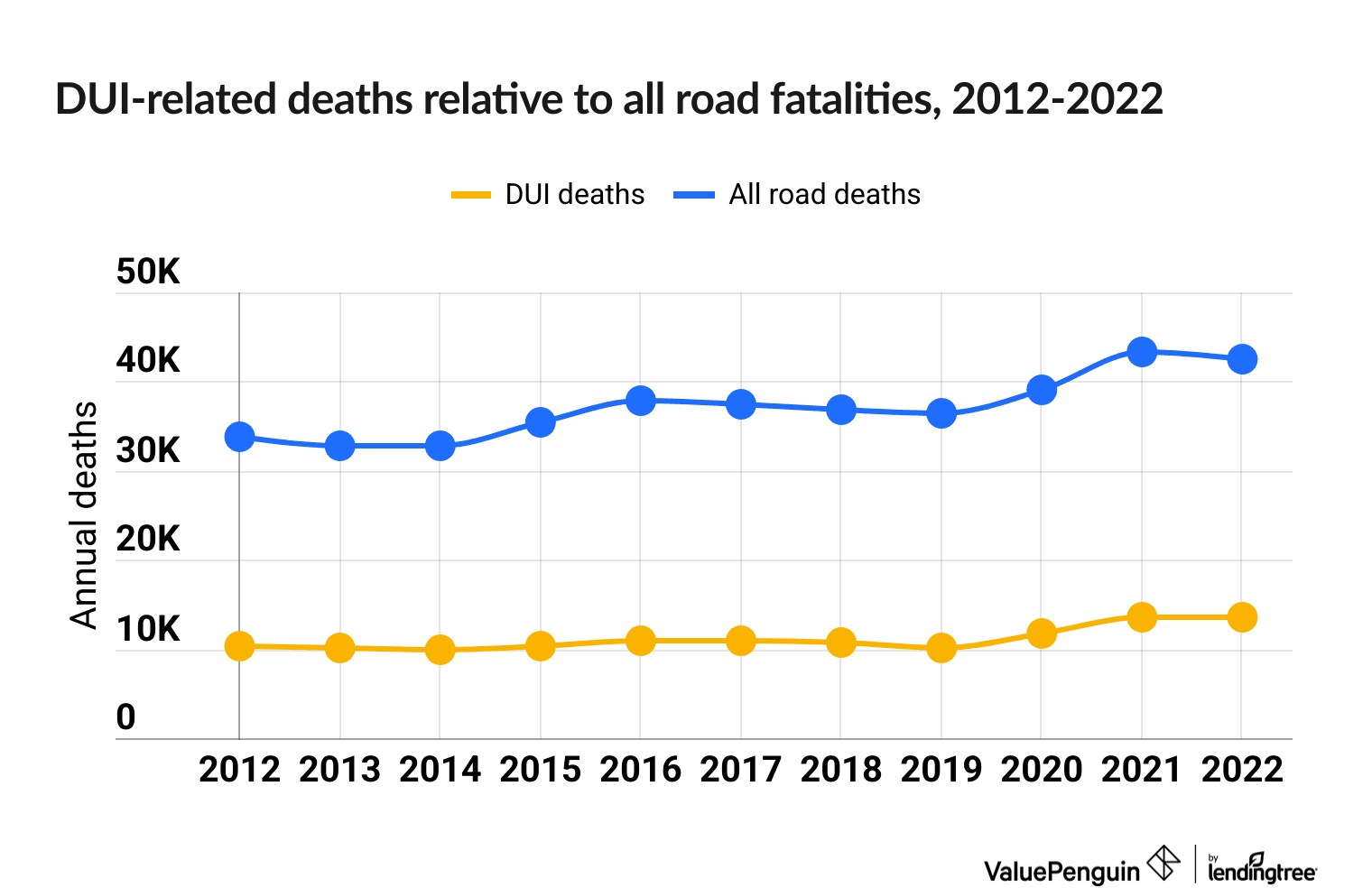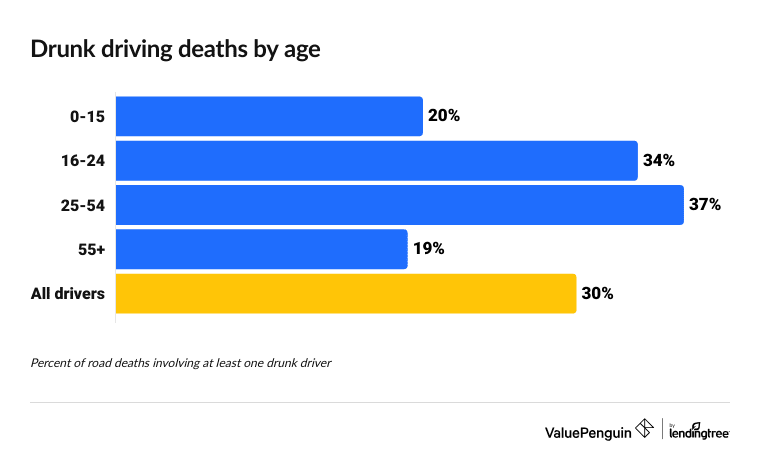Drunk Driving Statistics
Drunk driving is responsible for about 1 in 3 traffic fatalities in the United States, according to data ValuePenguin analyzed from the National Highway Traffic Safety Administration (NHTSA). The frequency of alcohol-impaired driving accidents can vary depending on the driver's age, their location and the time of year.
The breakdowns on this page evaluate crashes where a driver's blood alcohol concentration (BAC) was equal to or greater than 0.08.
How many people die from drunk driving?
More than 122,000 people were killed in a drunk driving accident between 2012 and 2022.
The annual number of fatal traffic accidents involving drunk driving increased by 31% between 2012 and 2022, according to the National Highway Traffic Safety Administration (NHTSA). Fatalities increased from about 10,336 to 13,524 per year. DUI-related crashes were connected to about 30% of all road deaths during that time.
There was a small but consistent yearly decline in the percentage of road deaths that involved a drunk driver from 2012 to 2019, until the trend reversed itself during the COVID-19 pandemic. The years 2020, 2021 and 2022 all saw an increase in the percentage of road deaths involving a drunk driver.
That increase outpaced the overall number of road deaths during that time — overall, 26% more people were killed on American roads in 2022 than in 2012.

Is drunk driving a felony?
Receiving one conviction for drunk driving is ordinarily a misdemeanor, not a felony. The penalty for a misdemeanor doesn't involve jail time but could include a fine or community service — along with substantial hikes to your car insurance premiums.
However, drunk drivers could face felony charges if they injure or kill another person. Additionally, being pulled over while drunk with a minor in the car, or with a suspended license, among others, could result in a felony charge for drunk driving.
Drunk driving deaths by state
Texas had the largest percentage of fatalities resulting from drunk driving of any state between 2012 and 2022: 40% of traffic deaths there were owed to alcohol-impaired drivers.
Texas also had the most traffic deaths from drunk driving with more than 16,000 drunk driving fatalities.
Around 30% of roadway fatalities each year involve at least one alcohol-impaired driver, but some states have far higher rates of alcohol-related fatalities. In five states, more than 35% of road deaths involved a drunk driver.
Utah had the lowest percentage of drunk driving deaths, with only 20% of the total number of traffic deaths in the state being the result of alcohol-impaired driving. Kentucky had the second-lowest rate of DUI-related deaths, at 23%.
State | Deaths from alcohol-impaired driving | Percentage of statewide traffic deaths |
|---|---|---|
| Alabama | 2,885 | 28% |
| Alaska | 236 | 30% |
| Arizona | 3,172 | 29% |
| Arkansas | 1,604 | 26% |
| California | 11,939 | 29% |
| Colorado | 1,936 | 30% |
| Connecticut | 1,243 | 39% |
| Delaware | 406 | 30% |
| District of Columbia | 97 | 32% |
| Florida | 9,064 | 27% |
| Georgia | 4,046 | 25% |
| Hawaii | 392 | 34% |
All figures based on traffic deaths where the highest BAC among all drivers was higher than .08..
Drunk driving deaths by age group
Adults between 25 and 54 are the most likely age group to be killed in a drunk driving accident.
Overall, a drunk driver was involved in 37% of road deaths of middle-aged people.

Conversely, there were fewer alcohol-related deaths among the oldest and youngest people on the roads. About 20% of under-16 road deaths involved alcohol, while just 19% of people over 55 were killed in an alcohol-related crash.
Road deaths that involved alcohol, by age
Age | Number of alcohol-related deaths | Percent of all fatalities |
|---|---|---|
| 0-15 | 2,919 | 20% |
| 16-24 | 24,462 | 34% |
| 25-54 | 70,160 | 37% |
| 55+ | 24,416 | 19% |
Which holidays have the most drunk-driving accidents?
From 2012 to 2022, there were more fatal crashes involving drunk driving on the Fourth of July, Labor Day and Memorial Day Weekend than in the winter holidays of Thanksgiving and Christmas. Two-thirds of the fatal alcohol-related crashes that occurred around holidays happened in summer. In total, there were more than 5,670 alcohol-related fatal crashes between 2012 and 2022 that occurred during summer holiday periods.
On average, DUI deaths are 65% higher during \tt holiday periods than the rest of the year.
Together, Labor Day, Memorial Day, the Fourth of July, Thanksgiving and Christmas all accounted for about 8% of the total number of traffic deaths from drunk driving. Christmas has the fewest DUI deaths on average, with just 1,300 total deaths between 2012 and 2022.
Total DUI deaths | DUI deaths per day of holiday period | |
|---|---|---|
| Fourth of July | 1,910 | 560 |
| Labor Day | 1,901 | 543 |
| Memorial Day | 1,859 | 531 |
| Thanksgiving | 1,843 | 410 |
| Christmas | 1,300 | 381 |
| All holidays | 8,813 | 481** |
| Other days | 113,450 | 292 |
The NHTSA calculates the length of each holiday period based on the day of the week the holiday occurs. For example, the holiday period for a Sunday or Monday goes from 6 p.m. Friday until 6 a.m. Tuesday. The figures in this table are based on the average holiday period length between 2012 and 2022.
Most dangerous types of roads for drunk driving
Fatal crashes involving alcohol-impaired driving most often occurred on state highways between 2012 and 2022. The number of fatal alcohol-related crashes on state highways has made up 28% of the country's total number of alcohol-related fatal accidents. More than 34,000 people were killed in alcohol-related crashes on state highways during this period.
Local roads saw about 21% of the total fatal alcohol-related crashes that occurred nationwide.
County roads were responsible for a large share of roadway fatalities. There were nearly 20,000 fatalities involving alcohol and driving on these roads, making up 16% of the national total. This means that alcohol-impaired drivers were responsible for about 36% of the total traffic deaths that occurred on county roads.

How drunk driving affects car insurance
The cost of a full coverage car insurance policy in the nation's 10 largest states can increase by an average of 85% after a DUI conviction, according to ValuePenguin's analysis.
The largest price surge happened in North Carolina, where drivers can expect to pay rates four times higher after a DUI. Rates in Hawaii also more than tripled, and drivers in eight more states will typically pay more than double.
Only two states saw the average cost of insurance rise by less than 50%. That was in Oklahoma and Texas, where the cost of car insurance increased by 50% and 40%, respectively.
State | DUI rate | Price increase after DUI |
|---|---|---|
| Alabama | $311 | 60.31% |
| Alaska | $219 | 55.32% |
| Arizona | $350 | 60.55% |
| Arkansas | $307 | 59.07% |
| California | $477 | 183.93% |
States are arranged by their population, from most- to least-populated.
Drivers who are convicted of driving while intoxicated may be deemed high risk and have to purchase SR-22 insurance. An SR-22 isn't a form of coverage. Rather, it's a certificate filed by the driver's insurance provider that shows financial responsibility. Drivers whose licenses have been suspended after a DUI, or other high-risk behavior, may have to purchase an SR-22 before they can get their license back.
What state has the lowest blood alcohol limit?
Utah has the lowest blood alcohol limit in the country. The state lowered the limit to 0.05 in 2018, which made Utah the only state to not have a baseline BAC of 0.08.
At least four more states — including Delaware, Hawaii, Oregon and Washington — have considered legislation to lower their limits, too.
Methodology
ValuePenguin analyzed drunk driving trends in the country using road fatality data from the National Highway Traffic Safety Administration's (NHTSA) Fatality Analysis Reporting System (FARS).
For the section "Which holidays have the most drunk-driving accidents," ValuePenguin used the time periods stored in the NHTSA's Fatality Analysis Reporting System (FARS) database. These holiday periods include not just the single date a holiday falls on (Dec. 25, for example), but also days of the week around the focal day, especially when Fridays, Saturdays and Sundays were close.
For DUI car insurance rates, ValuePenguin compared the cost of insurance for a 30-year-old male driver before and after a DUI from across all 50 states.
ValuePenguin's analysis used insurance rate data from Quadrant Information Services. These rates were publicly sourced from insurer filings and should be used for comparative purposes only — your own quotes may be different.
Editorial Note: The content of this article is based on the author's opinions and recommendations alone. It has not been previewed, commissioned or otherwise endorsed by any of our network partners.
